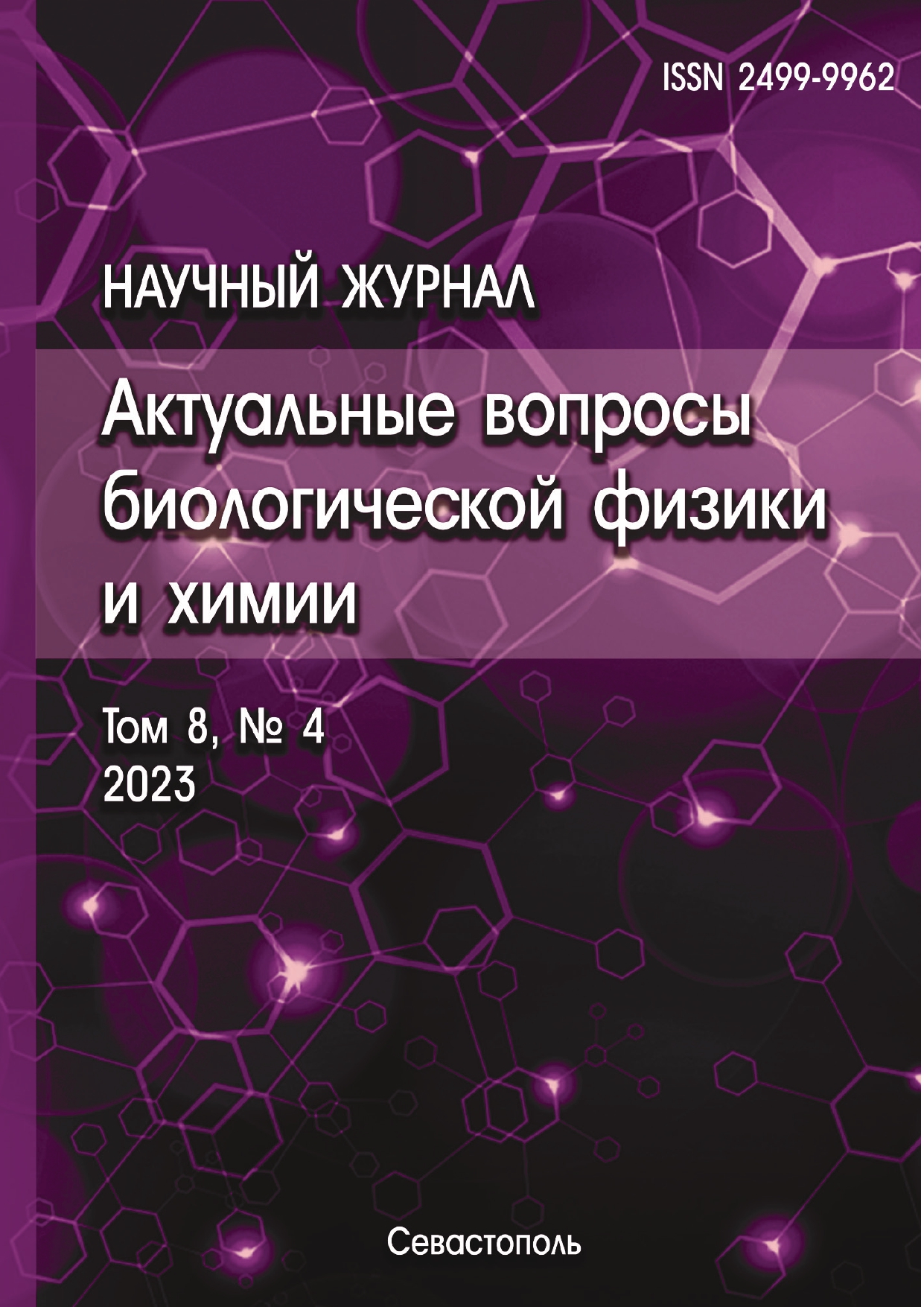Sevastopol, Sevastopol, Russian Federation
Sevastopol, Sevastopol, Russian Federation
Sevastopol, Sevastopol, Russian Federation
The study of light-dependent growth of butch culture Phaeodactylum tricornutum has been carried out. Based on the developed mathematical model of the true absorption spectrum, an express method for determining the concentration of photosynthetic pigments without interfering with the growth process of the culture was proposed. In the exponential phase at an irradiance of 120 μE·m-2·s-1, the maximum specific synthesis rates of chlorophylls a and c were determined, which were 1,4 times higher than the specific growth rate of the culture and amounted to 0,3 day-1. On the eighth day of the experiment, a kink in the growth curve was observed, which was expressed as a decrease in both growth rate and chlorophyll production. At the transition to the linear growth phase, the maximum productivity of Pheodactylum was 0,15 g·l-1·day-1, and chlorophyll production was 3,44 and 2,85 mg·l-1·day-1 a and c, respectively. The dependence of the integral light absorption coefficient on chlorophyll a concentration was obtained, which is described by the Bouguer-Lambert-Bera law with a sufficient degree of accuracy; the specific light absorption coefficient was 0,10 m2·g-1 dry matter and 0,008 m2·mg-1 chlorophyll a. Comparison of the results obtained with literature data showed that at irradiances of 120 μE·m-2·s-1 and 602 μE·m-2·s-1 the specific rates of chlorophyll a synthesis are the same, and the maximum specific growth rate of Ph. tricornutum culture increases proportionally with increasing light intensity from 0,23 to 0,91 day-1. The results obtained indicate that chlorophyll a synthesis is determined not by the effective light intensity, but by the amount of reserve biomass accumulated during the previous light period.
modeling, specific growth rate, productivity, irradiation, chlorophyll a, light absorption coefficient
1. Yang R., Wei D., Xie J. Diatoms as cell factories for high-value products: chrysolaminarin, eicosapentaenoic acid, and fucoxanthin. Crit Rev Biotechnol, 2020, vol. 40, no. 7, pp. 993-1009. DOI: https://doi.org/10.1080/07388551.2020.1805402; EDN: https://elibrary.ru/HAXCMR
2. Trenkenshu R.P. Growth of microalgae during the transition from darkness to constant illumination. Questions of modern algology, 2018, no. 2(17) (In Russ.).
3. Palamodova O.S. Dynamics of photoadaptation of some species of diatom algae. Marine Ecology, 2009, iss. 78, pp. 70-74 (In Russ.). EDN: https://elibrary.ru/UKIWWH
4. Anning T., MacIntyre H.L., Pratt S.M., Sammes P.J., Gibb S., Geider R.J. Photoacclimation in the marine diatom Skeletonema costatum. Limnol. Oceanogr., 2000, vol. 45, no. 8, pp 1807-1817, doi:https://doi.org/10.4319/lo.2000.45.8.1807.
5. Wang W., Yu L.J., Xu C., Tomizaki T., Zhao S., Umena Y., Chen X., Qin X., Xin Y., Suga M., Han G., Kuang T., Shen J.R. Structural basis for blue-green light harvesting and energy dissipation in diatoms. Science, 2019, vol. 363, no. 6427, 598 p.
6. Kupper H., Seibert S., Parameswaran A. Fast, sensitive, and inexpensive alternative to analytical pigment HPLC: quantification of chlorophylls and carotenoids in crude extracts by fitting with Gauss peak spectra. Analyt. Chem, 2007, vol, 79, no. 20, pp. 7611-7627.
7. Trenkenshu R.P., Lelekov A.S., Borovkov A. B., Novikova T. M Unified installation for laboratory research of microalgae. Questions of modern algology, 2017, no. 1(13) (In Russ.).
8. Trenkenshu R.P., Terskov I.A., Sidko F.Ya. Dense cultures of marine microalgae. Bulletin of the Siberian Branch of the USSR Academy of Sciences. A series of biological sciences, 1981, vol. 5, no. 1, pp.75-82 (In Russ.).
9. Jeffrey S.W., Mantoura R.F.C., Wright S.W. Phytoplankton pigments in oceanography: guidelines to modern methods. UNESCO, 1997, 661 p.
10. Merzlyak M.N., Naqvi K.R. On recording the true absorption and scattering spectrum of a turbid sample: application to cell suspensions of the cyanobacterium Anabaena variabilis. J. Photochem. Photobiol. B: Biology, 2000, vol. 58, pp. 123-129, doi:https://doi.org/10.1016/s1011-1344(00)00114-7. EDN: https://elibrary.ru/LFVJHL
11. Klochkova V.S., Lelekov A.S., Gevorgiz R.G., Shiryaev A.V., Buchelnikov A.S., Shupova E.V. Changes in the optical density spectrum of the accumulation culture of Arthrospira (Spirulina) platensis. Actual questions of biological physics and chemistry, 2021, vol. 6, no. 4, pp. 543-547 (In Russ.). EDN: https://elibrary.ru/AQDDHI
12. Gevorgiz R.G., Shmatok M.G. Lelekov A.S. Calculation of the efficiency of photobiosynthesis in lower phototrophs. Continuous culture. Marine Ecology, 2005, vol. 70, pp. 31-36 (In Russ.). EDN: https://elibrary.ru/THJRVY
13. Trenkenshu R.P., Lelekov A.S. Modeling of microalgae growth. Belgorod: CONSTANTA LLC, 2017, 152 p. (In Russ.). EDN: https://elibrary.ru/XTJPCH
14. Chernyshev D.N., Klochkova V.S., Lelekov A.S. Modeling of the absorption spectrum of Phaeodactylum tricornutum Bohlin culture in the red region. Questions of modern algology, 2023 (In Russ.).
15. Lelekov A.S., Chernyshev D.N., Klochkova V.S. Quantitative regularities of growth of the accumulative culture of Arthrospira platensis. Mathematical Biology and Bioinformatics, 2022, vol. 17, no. 1, pp. 156-170 (In Russ.). DOI: https://doi.org/10.17537/2022.17.156; EDN: https://elibrary.ru/XTTLPU
16. Efimova T.V. Action of the spectral composition of light on structural and functional characteristics of microalgae: Cand. of Biological Sciences. Sevastopol, 2021, 28 p. (In Russ.). EDN: https://elibrary.ru/QCQHXG
17. Nymark M., Valle K.C., Brembu T., Hancke K, Winge P., Andresen K. et al. An Integrated Analysis of Molecular Acclimation to High Light in the Marine Diatom Phaeodactylum tricornutum. PLoS ONE, 2009, vol. 4, no. 11, p. e7743, doi:https://doi.org/10.1371/journal.pone.0007743.
18. Flynn K.J. A mechanistic model for describing dynamic multi-nutrient, light, temperature interaction in phytoplankton. J. Plan. Res, 2001, vol. 23, pp. 977-997, doi:https://doi.org/10.1093/PLANKT/23.9.977. EDN: https://elibrary.ru/IYRWOJ
19. Lelekov A.S., Trenkenshu R.P. Modeling of dynamics of macromolecular composition of microalgae in accumulation culture. Computer Research and Modeling, 2023, vol. 15, no. 3, pp. 739-756 (In Russ.). DOI: https://doi.org/10.20537/2076-7633-2023-15-3-739-756; EDN: https://elibrary.ru/RYULWB
20. Jallet D., Caballero M.A., Gallina A.A., Youngblood M., Peers G. Photosynthetic physiology and biomass partitioning in the model diatom Phaeodactylum tricornutum grown in a sinusoidal light regime. Algal Research, 2016, vol. 18, pp. 51-60, doi:https://doi.org/10.1016/j.algal.2016.05.014. EDN: https://elibrary.ru/YDPVXB










